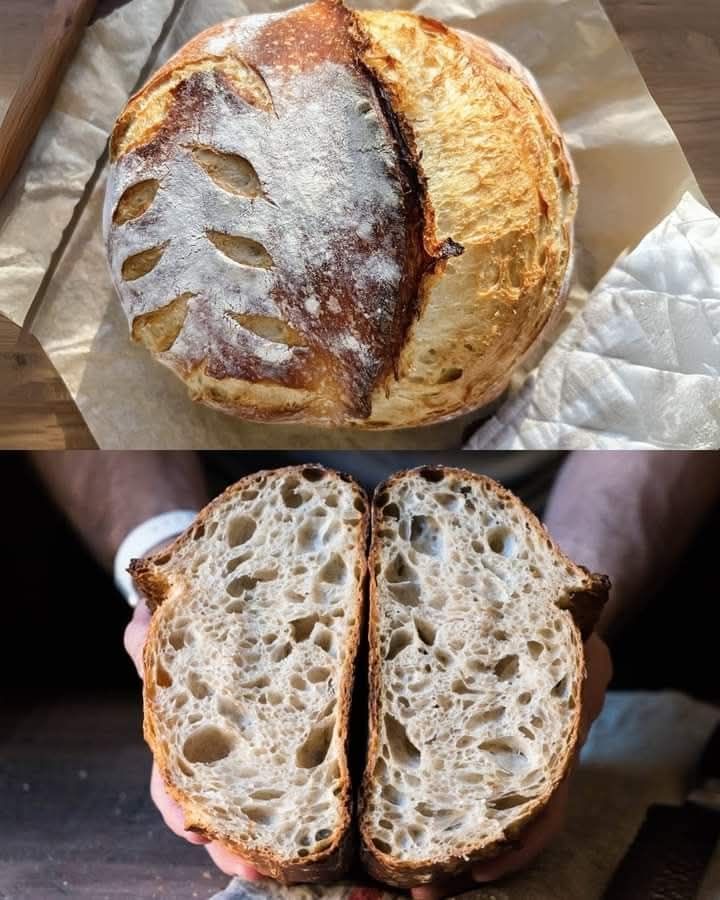Sourdough Bread Recipe
Ingredients
- 200g (1 cup) fresh sourdough starter: The live culture that helps the dough rise and provides that signature sourdough flavor.
- 600g (5 cups) wheat flour: This will form the bulk of your dough, contributing to its structure and chewiness.
- 400g (3¼ cups) all-purpose flour or bread flour: Enhances the bread’s texture and adds additional protein for better gluten formation.
- 20g (1 tbsp) salt: Essential for flavor and helps strengthen the gluten structure in the dough.
- 700g (3 cups) water + 30g (2 tbsp) water (for mixing with salt later): Water hydrates the flour, activating the gluten and helping the fermentation process.
- Note: For a more open crumb, use 800g (3½ cups) water. If using spelt flour, adjust to 650g (2¾ cups) water + 30g (2 tbsp) water.
Directions
- Prepare the Sourdough Leaven:
- Begin by feeding your sourdough starter about 8 hours before you plan to start baking. This step is crucial for ensuring that your starter is fully risen and active. The ideal temperature for the starter to rise is around 75°F to 80°F (24°C to 27°C). Once it has doubled in size and is bubbly, it’s ready to be used.
- Prepare the Sourdough Leaven:
- Mix the Dough:
- In a large mixing bowl, combine 200g of your active sourdough starter, 600g of wheat flour, 400g of all-purpose flour, and 700g of water. Use a wooden spoon or your hands to mix until the dough starts to come together. Make sure all the flour is hydrated, and there are no dry spots. Once mixed, let the dough rest for about 1 hour. This resting period, known as the autolyse, allows the flour to fully absorb the water and makes the dough easier to work with later.
- After the autolyse, dissolve 20g of salt in 30g of water. This step is important as it helps the salt to evenly distribute throughout the dough without creating tough spots. Once dissolved, fold this saltwater mixture into the dough. Perform a stretch and fold technique: with wet hands, grab one edge of the dough, stretch it up, and fold it over to the center. Rotate the bowl and repeat this process until the salt is fully incorporated.Add Salt and Water:
- Stretch and Fold Sessions:
- Allow the dough to rise for 4 hours, performing a stretch and fold every 30-60 minutes during this time. To stretch and fold, gently pull the dough from the sides and fold it over to the center. This technique helps to develop the gluten structure and aerate the dough, leading to a light and airy crumb. After each stretch and fold, let the dough rest, covered, until the next session.
- Mix the Dough:
- Shape the Dough:
- Once the dough has increased in volume and shows bubbles on the surface, divide it into two equal portions on a lightly floured surface. Shape each portion into round balls by folding the edges toward the center and then flipping them over to create a smooth top. Let the shaped dough rest on the counter, covered with a damp cloth or plastic wrap, for about 1 hour. This short resting period helps the gluten relax and makes final shaping easier.
- Final Shaping:
- After the resting period, it’s time for final shaping. Depending on your preference, shape the dough into either rectangles for long loaves or rounds for artisan bread. To shape a round loaf, flip the dough seam side up, gently flatten it, and then fold the edges into the center to create tension on the surface. Use your hands to round it into a tight ball.
- Proof Overnight:
- Once shaped, place the dough in a proofing basket or loaf pan, seam side up for rounds or seam side down for logs. Cover it with a cloth or plastic wrap, and refrigerate it uncovered for 12 hours. The cold fermentation develops complex flavors in the dough and improves the texture of the final loaf.
- Shape the Dough:
- Preheat and Bake:
- About 30 minutes before you plan to bake, preheat your oven to 450ºF (232ºC). If using a Dutch oven, place it in the oven to heat up as well. For artisan bread, after the oven is preheated, carefully flip the loaf into the hot pan, score the top with a sharp knife or razor blade to allow steam to escape, and cover with the lid. Bake for 30 minutes. After this time, remove the lid, reduce the heat to 350ºF (175ºC), and bake for an additional 15-20 minutes until the crust is a deep golden brown and sounds hollow when tapped.
- For sandwich bread, set your oven to 350ºF (175ºC) and bake for 45 minutes. This lower temperature will help to ensure even baking throughout the loaf.
- Preheat and Bake:
- Cool the Bread:
- Once baked, carefully remove the bread from the oven and let it cool on a wire rack. Allowing the bread to cool completely before slicing is essential, as it continues to steam and firm up the crumb structure. This cooling process usually takes about 1 hour.
- Slice your freshly baked sourdough bread and enjoy it warm or at room temperature. It’s perfect for sandwiches, toast with butter or jam, or served as a side with soups and stews. You can also serve it with olive oil and balsamic vinegar for a delicious dipping option.Serve and Enjoy:
Cooking Tips
- For a Crispier Crust: Mist the oven with water just before placing the bread inside. This steam helps to develop a beautiful crust.
- Using a Dutch Oven: A Dutch oven or heavy baking pan helps create steam, giving the bread a better rise and crust.
- For Softer Crust: Brush the loaf with melted butter immediately after baking for a softer crust.

